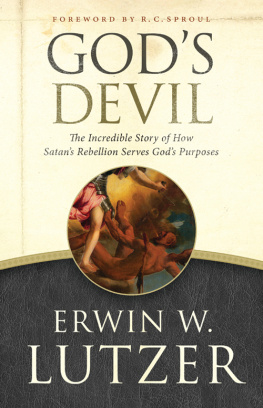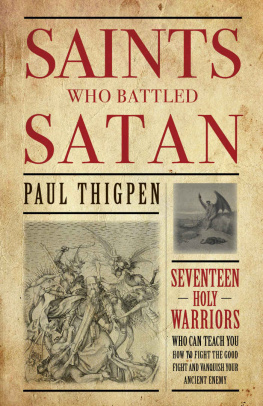
THE
SATAN
How Gods
Executioner
Became the Enemy
Ryan E. Stokes
WILLIAM B. EERDMANS PUBLISHING COMPANY
GRAND RAPIDS, MICHIGAN
Wm. B. Eerdmans Publishing Co.
4035 Park East Court SE, Grand Rapids, Michigan 49546
www.eerdmans.com
2019 Ryan E. Stokes
All rights reserved
Published 2019
252423222120191234567
ISBN 978-0-8028-7250-0
eISBN 978-1-4674-5715-6
Library of Congress Cataloging-in-Publication Data
Names: Stokes, Ryan E., 1977 author.
Title: The Satan : how Gods executioner became the enemy / Ryan E. Stokes.
Description: Grand Rapids, Michigan : William B. Eerdmans Publishing Company, 2019. | Includes bibliographical references and index.
Identifiers: LCCN 2018056929 | ISBN 9780802872500 (pbk. : alk. paper)
Subjects: LCSH: DevilHistory of doctrines. | DevilBiblical teaching.
Classification: LCC BT982 .S76 2019 | DDC 235/.47dc23
LC record available at https://lccn.loc.gov/2018056929
Contents
T he great dragon was thrown down, that ancient serpent, who is called the Devil and Satan, the deceiver of the whole worldhe was thrown down to the earth, and his angels were thrown down with him (Rev 12:9).
So says the book of Revelation, narrating a vision of John of Patmos. In Johns vision, Satan was thrown down from heaven because the followers of Jesus had defeated him by the blood of the Lamb and by the word of their testimony, for they did not cling to life even in the face of death (12:11). This casting down, however, was not the final demise of Satan. Later we read that after Christ appears from heaven as a warrior riding a white horse, an angel seizes the dragon, that ancient serpent, who is the Devil and Satan, binds him for a thousand years, and throws him into the pit (20:23). Even then he is not finished. After the thousand years are ended, Satan is released from his prison and comes out to deceive the nations and gather them for battle. His host is destroyed, however, by fire from heaven, and Satan himself is finally thrown into the lake of fire and sulfur, to be tormented day and night forever (20:10).
The book of Revelation does not describe the full history of Satan, but it provides hints to show that he has a history. His role in this world is said to escalate in the latter days when he is cast down from heaven. That he is variously known as the dragon, the ancient serpent, and the Devil hints that the figure we know as Satan has a complex history and various identities. Even Revelation does not yet assign to him the role for which he is best known in modern times, that of torturer of the damned in hell.
Satan as he appears in the book of Revelation is a prince of evil, the main adversary of God and Christ in the end time. It may come as a surprise to Christian readers that no such figure is known in the Hebrew Bible. The closest analogue, perhaps, is the figure to which Revelation refers as the dragon. In many ancient Near Eastern cultures, the process of creation is thought to have involved a battle between the creator god and a sea monsterTiamat in the Babylonian Enuma Elish, Yamm (Sea) in the Canaanite Baal myth known from texts found at Ugarit in northern Syria. We find allusions to similar creation stories in the poetic books of the Hebrew Bible. So Job 26:12: By his power he stilled the Sea; by his understanding he struck down Rahab. Or again, in Isa 51:9: Awake, awake, put on strength, O arm of the Lord! Awake as in days of old, the generations of long ago! Was it not you who cut Rahab in pieces, who pierced the dragon? In Isa 27:1, the battle with the monster is projected into the future: On that day, the Lord with his cruel and great and strong sword will punish Leviathan the fleeing serpent, Leviathan the twisting serpent, and he will kill the dragon that is in the sea. When Daniel sees the four winds of heaven stirring up the great sea, and four great beasts coming up out of it (Dan 7), this too is a reflection of the same mythic tradition, as indeed is the beast from the sea in the book of Revelation.
But while the dragon is an eschatological adversary of God, it is not a force of moral evil. It rather represents chaosall the forces that threaten life and flourishing. It can represent natural forces or political entities, but it is not usually concerned with individuals. It is not a tempter, nor one who leads people astray.
The idea of the tempter is associated in popular imagination especially with the snake in the garden of Eden, the ancient serpent of Revelation. But the snake in Genesis is not a supernatural agent. Rather the story in Genesis is a fable that expresses the lure of temptation in a literary way. It was not until the first century CE that the snake was identified with the devil (in Wis 2:24, written in Alexandria about the time of Christ).
The figure of Satan does appear in the Hebrew Bible. Best known is his appearance in the book of Job, where he serves Yahweh by going to and fro upon the earth and testing people. Here he is clearly Gods agent and has not yet been expelled from the heavenly council. Ryan Stokes makes the case that originally the satan was Gods executioner. The expression the satan is not a proper name but refers to a role. In the story of Balaam in Num 22, it can even be played by the angel of Yahweh. In Job, however, this figure is transformed into one who also attacks the righteous. The book of Job, then, is pivotal in the development of the figure of Satan, even though he is still far from the character described in the book of Revelation.
The crucial period for the development of the figure of Satan, however, was the Hellenistic age, especially the last two centuries before the Common Era. The Book of the Watchers, in 1 En. 136, tells the story of the fallen angels, or watchers, who beget evil spirits on the earth. These evil spirits have much in common with the demons of Mesopotamian incantation texts. Unlike the evil spirit that troubled Saul in 1 Samuel, these spirits are not affiliated with God. Unlike the Mesopotamian demons, they not only afflict people with illness but become instigators of sin.
In the book of Jubilees, the leader of these evil spirits is called Mastema, but his character is that traditionally associated with Satan. When Noahs sons beseech God to banish these spirits, Mastema lodges an appeal, asking God to let some of them remain: For if some are not left me, I shall not be able to exercise over men the authority I want; for these are destined for corruption and to be led astray (Jub. 10:78). Remarkably, God agrees. One-tenth of the evil spirits are allowed to remain on earth, while nine-tenths descend to the place of punishment.
The mythology of evil spirits underwent further development in the Dead Sea Scrolls. Here the leader of evil spirits is given other names, most prominently Belial. (The word is used in the Hebrew Bible, but not as a proper name. Sons of Belial is a designation for evil people.) Most significant is the Treatise on the Two Spirits in the Community Rule (1QS 34). Here we are told that when God created human beings, he gave them two spirits, one of light and one of darkness. These struggle within the hearts of individuals and incline them toward good or evil. God has assigned them equal measure until the final judgment. Another text from the scrolls, the War Rule, describes a final battle between the children of Light, led by the archangel Michael, and the children of Darkness, led by Belial. The battle is divided into seven phases. The forces of Light and the forces of Darkness each prevail in three phases until God intervenes decisively in the final phase.















